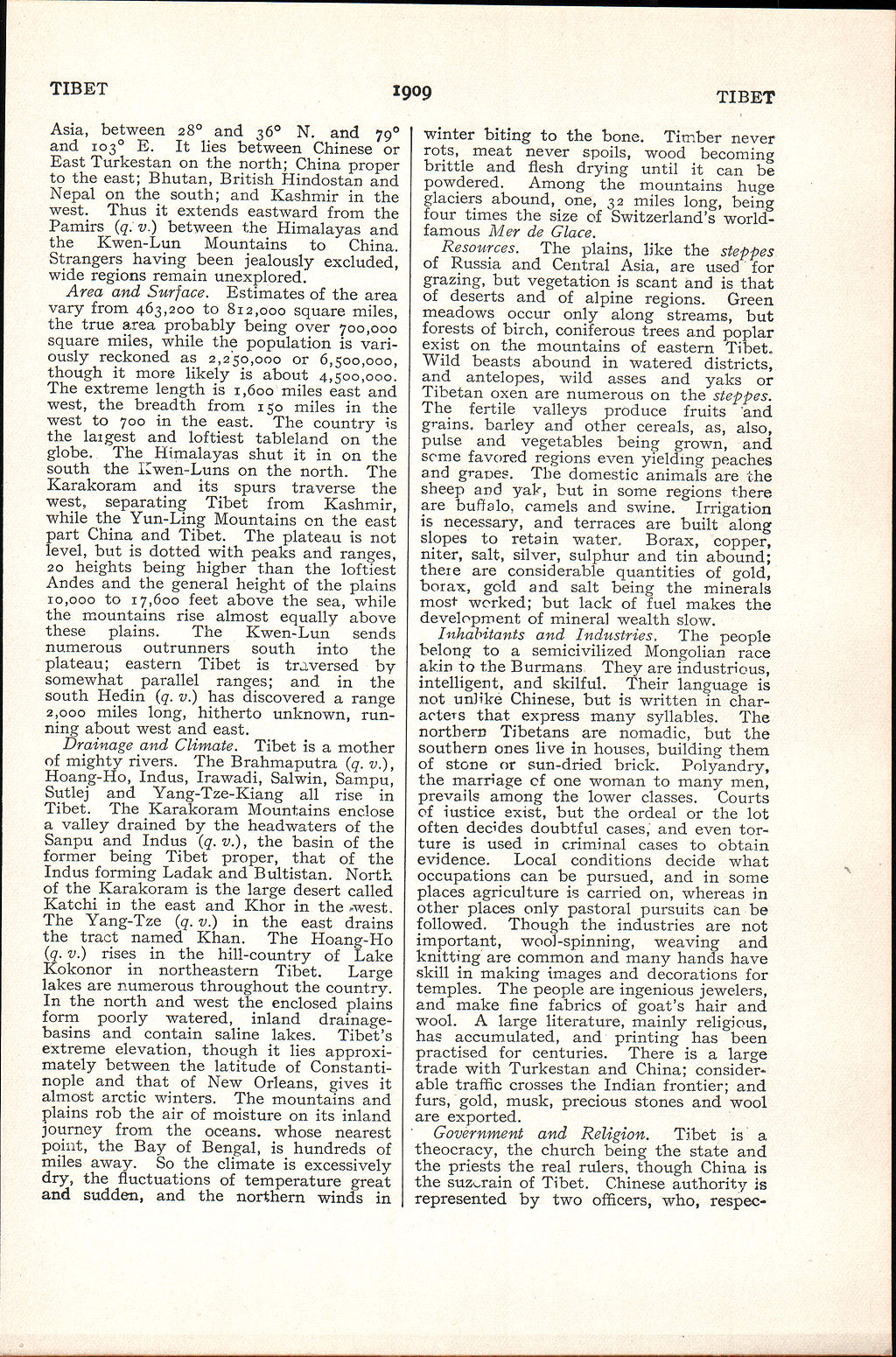TIBET
1909
TIBET
Asia, between 28° and 36° N. and 79° and 103° E. It lies between Chinese or East Turkestan on the north; China proper to the east; Bhutan, British Hindostan and Nepal on the south; and Kashmir in the west. Thus it extends eastward from the Pamirs (q. v.) between the Himalayas and the Kwen-Lun Mountains to China. Strangers having been jealously excluded, wide regions remain unexplored.
Area and Surface. Estimates of the area vary from 463,200 to 812,000 square miles, the true area probably being over 700,000 square miles, while the population is variously reckoned as 2,250,000 or 6,500,000, though it more likely is about 4,500,000. The extreme length is 1,600 miles east and west, the breadth from 150 miles in the west to 700 in the east. The country is the laigest and loftiest tableland on the globe. The Himalayas shut it in on the south the Kwen-Luns on the north. The Karakoram and its spurs traverse the west, separating Tibet from Kashmir, while the Yun-Ling Mountains on the east part China and Tibet. The plateau is not level, but is dotted with peaks and ranges, 20 heights being higher than the loftiest Andes and the general height of the plains 10,000 to 17,600 feet above the sea, while the mountains rise almost equally above these plains. The Kwen-Lun sends numerous outrunners south into the plateau; eastern Tibet is traversed by somewhat parallel ranges; and in the south Hedin (g. v.) has discovered a range 2,000 miles long, hitherto unknown, running about west and east.
Drainage and Climate. Tibet is a mother of mighty rivers. The Brahmaputra (q. v.), Hoang-Ho, Indus, Irawadi, Salwin, Sampu, Sutlej and Yang-Tze-Kiang all rise in Tibet. The Karakoram Mountains enclose a valley drained by the headwaters of the Sanpu and Indus (q. v.), the basin of the former being Tibet proper, that of the Indus forming Ladak and Bultistan. North of the Karakoram is the large desert called Katchi in the east and Khor in the -west. The Yang-Tze (q. v.) in the east drains the tract named Khan. The Hoang-Ho (q. v.) rises in the hill-country of Lake Rokonor in northeastern Tibet. Large lakes are numerous throughout the country. In the north and west the enclosed plains form poorly watered, inland drainage-basins and contain saline lakes. Tibet's extreme elevation, though it lies approximately between the latitude of Constantinople and that of New Orleans, gives it almost arctic winters. The mountains and plains rob the air of moisture on its inland journey from the oceans, whose nearest point, the Bay of Bengal, is hundreds of miles away. So the climate is excessively dry, the fluctuations of temperature great and sudden, and the northern winds in
winter biting to the bone. Timber never rots, meat never spoils, wood becoming brittle and flesh drying until it can be powdered. Among the mountains huge glaciers abound, one, 32 miles long, being four times the size of "Switzerland's world-famous Mer de Glace.
Resources. The plains, like the steppes of Russia and Central Asia, are used for grazing, but vegetation is scant and is that of deserts and of alpine regions. Green meadows occur only along streams, but forests of birch, coniferous trees and poplar exist on the mountains of eastern Tibet* Wild beasts abound in watered districts, and antelopes, wild asses and yaks or Tibetan oxen are numerous on the steppes. The fertile valleys produce fruits "and grains, barley and other cereals, as, also, pulse and vegetables being grown, and seme favored regions even yielding peaches and grapes. The domestic animals are the sheep and yak, but in some regions there are buffalo, camels and swine. Irrigation is necessary, and terraces are built along slopes to retain water, Borax, copper, niter, salt, silver, sulphur and tin abound; theie are considerable quantities of gold, borax, gold and salt being the minerals most worked; but lack of fuel makes the development of mineral wealth slow.
Inhabitants and Industries, The people belong to a semicivilized Mongolian race akin to the Burmans They are industrious, intelligent, and skilful. Their language is not unlike Chinese, but is written in characters that, express many syllables. The northern Tibetans are nomadic, but the southern ones live in houses, building them of stone or sun-dried brick. Polyandry, the marriage cf one woman to many men, prevails among the lower classes. Courts of iustice exist, but the ordeal or the lot often decides doubtful cases, and even torture is used in criminal cases to obtain evidence. Local conditions decide what occupations can be pursued, and in some places agriculture is carried on, whereas in other places only pastoral pursuits can be followed. Though the industries are not important, wool-spinning, weaving and knitting are common and many hands have skill in making images and decorations for temples. The people are ingenious jewelers, and make fine fabrics of goat's hair and wool. A large literature, mainly religious, has accumulated, and printing has been practised for centuries. There is a large trade with Turkestan and China; considerable traffic crosses the Indian frontier; and furs, gold, rnusk, precious stones and wool are exported.
Government and Religion. Tibet is a theocracy, the church being the state and the priests the real rulers, though China is the suzerain of Tibet. Chinese authority is represented by two officers, who, respec-
